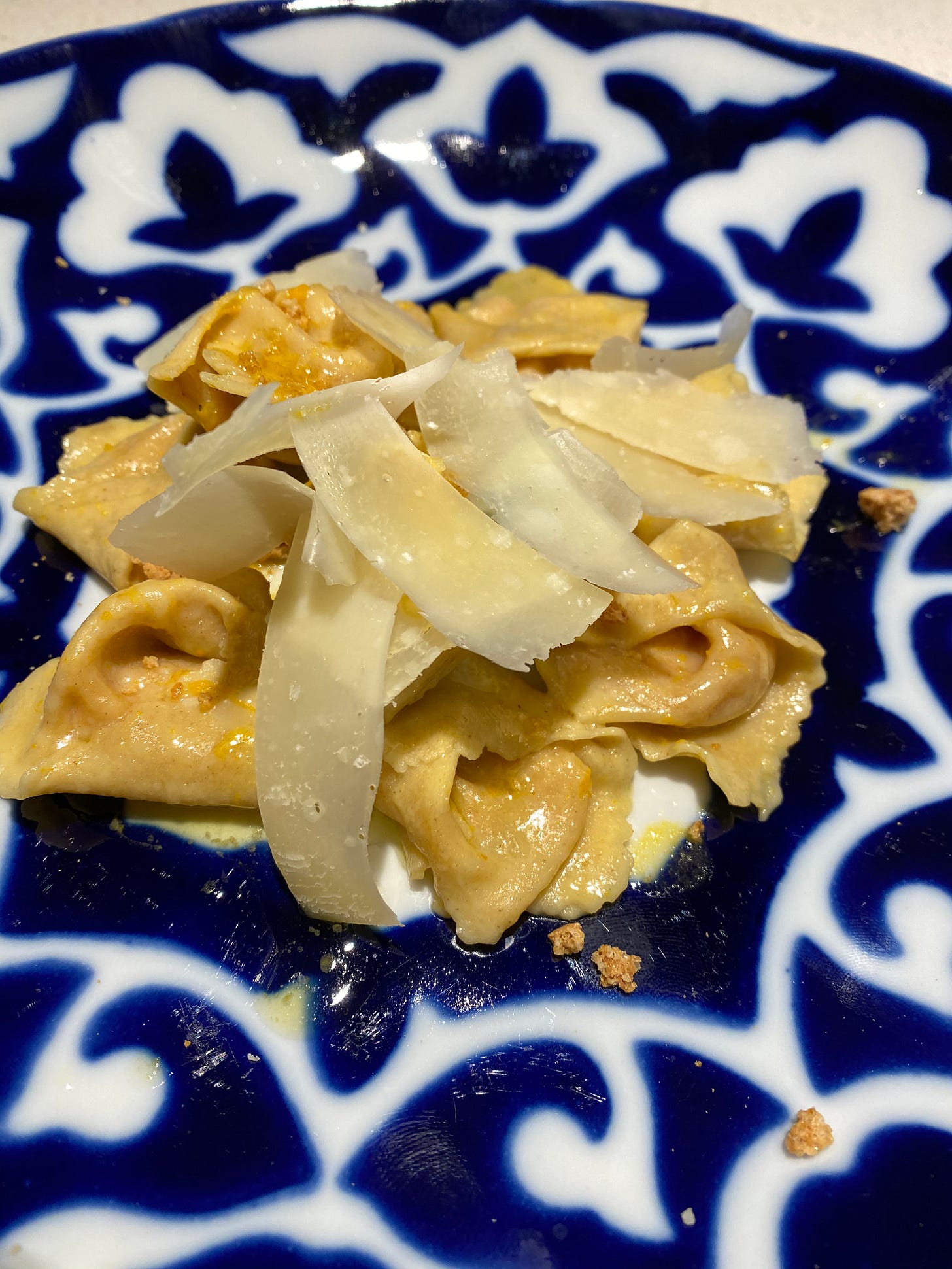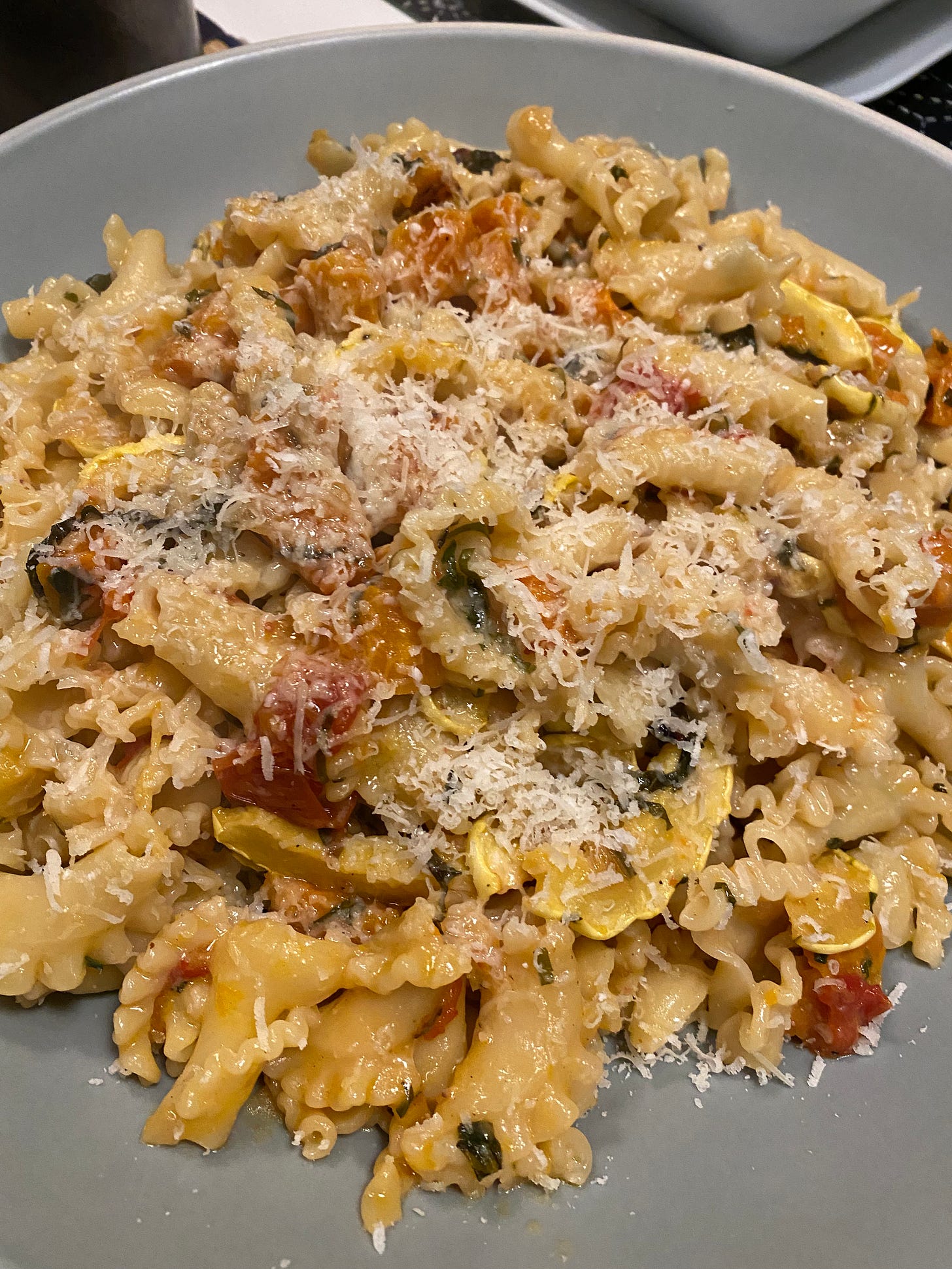Grammar in the Kitchen: Pasta, Italian–Style
Good Recipes vs. Great Cooks, Cuisine as Language, Trumpets with Roasted Squash
I am sending Issue #23 from Tel Aviv, where I am working on an exciting new project, Asif: Culinary Center of Israel. (Follow them on Instagram.) Opened in July, this new center for food is home to a multilingual culinary library, a test kitchen, a rooftop farm, an exhibition space, a robust website, and a café, all intended to deliver on the organization’s mission to explore and nurture the diverse food culture of Israel. It’s a beautiful place and an important project with programming and content in English, Hebrew, and Arabic. I’ll write more about Asif and the wonderful food I’m enjoying here in the coming weeks. Meanwhile, I noticed my Instagram post of a pasta last week was very popular, so that got me to thinking about cooking pasta in general and this recipe in specific. —Mitchell
Sometimes I feel like those of us in the food media have created a false sense of culinary accomplishment by leading people to believe that they can become great cooks just by following a recipe once or twice. Which is not to say that you can’t make something delicious simply by following a good recipe. In fact, fundamental to this newsletter is the idea that a good recipe produces good results. Gather a bunch of good recipes and you have a great meal.
But becoming a great cook takes more than that. It takes practice, repetition, failure, mindful attention to detail, the ability to make connections, and an understanding of consequences. A great cook has an embodied knowledge that comes from a combination of experience, both successes and failures, and sensory cognition. While I believe that everyone can become a great cook, it isn’t something that happens overnight.
Over the decades I’ve been cooking there have been a few times—a few cuisines, rather—that I sensed a crossover from simply following recipes to actually cooking. Though I can’t pinpoint the exact moment or the specific reasons, I know that there was food made before I really understood what I was doing, before I grasped the spirit of the cuisine, and food made after, that was better. For me, two distinct examples are Chinese and Italian.

I’ve loved the varied cuisines of China since I was a little kid and my family used to go Toronto’s Chinatown for Cantonese dim sum, Szechwan (this was before it was commonly spelled Sichuan) and Hunan food. I grew up watching Yan Can Cook and I remember trying to figure out how to stir fry when I was a teenager. But it would be more than 30 years before the Chinese food I cooked myself actually began to taste like something a Chinese person might recognize. Before that, the Chinese food I cooked didn’t even satisfy my own cravings.
If you think of a cuisine as a language, then the ingredients are letters, the dishes are words, and the rules about how you put them together are the grammar. (This is not my idea; see French structuralists.) There are things you do and things you don’t do. Some combinations make sense to those who “speak” the language, others are baffling. And sometimes you put things together in a way that is new and fresh, but that still makes sense in the context of the cuisine, itself. When I say that I understand Italian cuisine, I’m not saying that everything I make is some traditional Italian dish. But I know how to make a good pasta.
I’ve lived in Italy twice, attended school and taught there, and I’ve visited dozens of times. Italian food is a vast and subtle language, with pasta at its core. But the way many people outside of Italy make pasta would be unrecognizable by most Italians. Overcooking the pasta is the “don’t” most of us know. Add to that using fresh pasta for a sauce that demands dry, choosing the wrong shape for the type of sauce, adding too much sauce or too little, ladling the sauce on at the end rather than finishing the whole thing in a pan. I could go on.
When you set out to make up a pasta dish, especially if you aren’t following someone else’s recipe, there are things that make it seem Italian, even if such a dish is not part of the Italian pasta canon. If you use the correct grammar, it makes its own sense.
The other day I threw together a last-minute meal for some guests that was a success, I believe, because I did what an Italian might do. I know it was a success because I made enough for six or seven people, but four of us polished it off, each helping ourselves to thirds. And no, we weren’t starving. (I’m almost never hungry.)
Add this to the collection of recipes with roasted squash I proposed in Issue #19. In this instance, though, I’m not using a whole-roasted squash that I’ve puréed. Instead, I’m slicing and dicing squash and roasting it in small pieces so that it’s keeps its form when tossed with the noodles. Why more roasted squash? Well, winter is approaching and its a long squash season. Plus, some readers wrote about recipes they either followed or created after reading that issue (I see you Marcus and Phyllis), so I believe there is an appetite for more quick things you can cook to take advantage of this fruit of the season.
RECIPE: Pasta Trumpets with Roasted Squash, Cream, and Basil
About 4 cups winter squash, sliced or cubed (I used 1 delicata squash quartered lengthwise and sliced ¼” thick, skin on, and 2 small honey nut squash, peeled and diced, skin off)
Extra-virgin olive oil
Salt and freshly ground black pepper
1 tablespoon butter, plus more for finishing, at room temperature
½ large onion, finely chopped
½ cup dry white wine
1 cup vegetable or chicken stock
1 pound trumpets (aka campanelle or gigli), or other short, curly pasta
¼ cup sour or heavy cream
1 cup tightly packed cup opal, Thai or Italian basil leaves, roughly chopped
1 ounce Pecorino Romano, plus more for serving, finely grated
1 ounce Parmigiano Reggiano, plus more for serving, finely grated
Preheat the oven to 425°F. Scatter the sliced and/or cubed squash on a parchment-lined sheet pan. If using different squash, use separate pans in case they cook at different times. Drizzle with olive oil, season with salt and pepper, toss, and roast until soft and slightly browned, about 25 minutes. If the squash is cooked through but hasn’t browned, zap it under the broiler for a few minutes, watching closely so the parchment doesn’t burn. Cool and transfer to a bowl until ready to use. The squash can be roasted and refrigerated up to 2 days in advance.
Bring a large pot of generously salted water to a boil. While it is heating, prepare the sauce. In a large sauté pan, melt the butter along with a couple of tablespoons of olive oil over medium-high heat. Add the chopped onion, season with salt, stir, reduce the heat to medium low, and cook until the onion is an even, light caramel color, about 8 minutes. Don’t let it blacken or burn. When the onion attains a nice caramel color, add the wine, raise the heat to medium-high, and reduce until almost dry. Add about 1/3 cup of the vegetable stock and let it reduce as well. Repeat with another 1/3 cup of stock.
Meanwhile, if the water is boiling, add the pasta, stir, and cook just until al dente (read the cooking directions on the package for an idea of when to start checking doneness).
Back in the sauté pan, add the cream and stir until blended. Add the remaining stock and the roasted squash, and season with salt and pepper. Turn the heat to low to hold until the pasta is done.
When cooked, drain the pasta, reserving about ¼ cup of the cooking water. Do not rinse. Raise the temperature of the sauté pan back to medium-high. Add the basil leaves and mix to wilt. Add the noodles to the pan along with about 2/3 of each of the cheeses, a few tablespoons of the reserved pasta water, and a spoonful of butter and/or additional olive oil. Toss the pasta in the pan to evenly distribute the sauce, especially the squash and basil. Transfer to one large or individual warmed serving bowl(s), top with the remaining grated cheese, and serve immediately.
A Few Notes on Why I Believe this Pasta Dish Follows the Italian Grammar
The sauce is made at the same time as the pasta. While obviously this is not a rule, per se (see Bolognese), there is something about the simplicity of Italian pasta sauces that I think means for a weekday dinner you shouldn’t fuss too much.
There are few ingredients, not a cacophony of flavors, and the flavors are enhanced by reduction and concentration, not by the addition of spices. Salt and pepper are the only seasoning. Basil does the heavy lifting. The caramelization of the onions and roasting of the squash bolsters their inherent flavors.
The pasta is cooked al dente, even a little firmer than you might ultimately like it because you are going to finish it by cooking it in the pan, which leads me to…
It is finished in the pan, with the sauce, and mounted (montecato, in Italian) with cheese, butter, and olive oil. I’ve almost never seen a pasta that isn’t properly dress in padella before serving.
I realize this may seem like bragging, but it’s not intended that way. My Italian friends, especially one who owns an important pastificio, may take issue with every pasta I’ve made. I also realize you can cook pasta using other grammars besides Italian. You can add many different spices and flavorings, use totally different techniques, even cook your noodles to mush and still make a delicious dish. I can think of an uncountable number of amazing noodle dishes that are the product of a completely different set of rules or that follow no rules at all. That’s not my point. I’m just saying that once you have figured out a language, you can have fun speaking it. And I was happy with this pasta. I think you will be, too.





